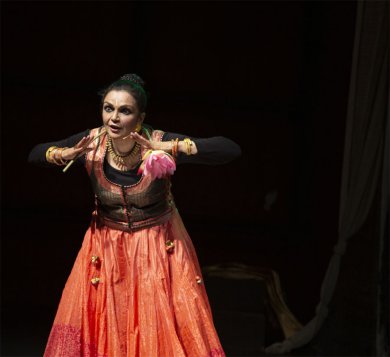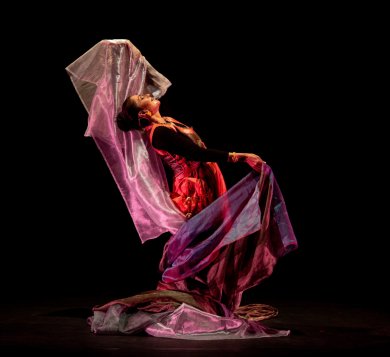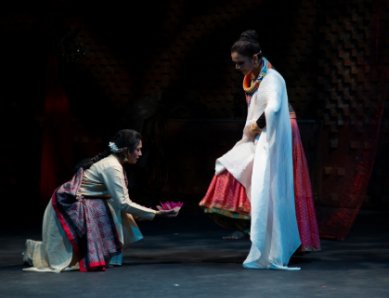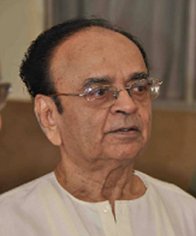
|   |

|   |
Suggestion elevates A Milllion Sitas to a high aesthetic level - Dr. S D Desai e-mail: sureshmrudula@gmail.com Photos: Jayanti Sagara February 2, 2020 Clusters of evocative images, both visual and aural, anchor Anita Ratnam's A Million Sitas and turn the literal to a work of art attaining a pretty high aesthetic level. Her basic format is storytelling with the Ramayana as her source. The performance held at Natarani on Jan 25 flowing like a stream moving past segment after a pleasing segment, assumes a distinctively different hue in the genre with suggestion as its mainstay. Even in its 40th show in ten years across four continents, it has the fragrance of a fresh garland ready for its central character Sita, who emerges like a fine sculpture of an elegant woman restored. 

The aural images, complementarily integral to Anita's manifold visual ones, are created by Sharanya with her exquisite vocal renderings, most in Carnatic music, now sitting with a low profile on the left with her charming repertoire, now rising and interacting with subdued brief dramatic interventions, and at times the enchanting rhythmic sounds N.K. Kesavan creates on his south Indian percussion instruments sitting within a magical raised semicircular platform under a tree at a distance on the right of the performance space. While Anita recedes for a while close to the Panchavati scene, Sharanya bursts into singing Meera's immortal lyric Paayoji maine Ram ratan dhan paayo... and immediately she balances it with the famous Gujarati song (Avinash Vyas) Ram tame Sitaji-ni tole na aavo ('You stand no comparison, dear Ram, with Sita'). She said on being asked at the end, she had added this local flavour after reaching Natarani! Why no comparison is all about the theme of the presentation. The performer-choreographer, who has developed the script drawing from quite a few of the numerous versions of the epic, has her research-based varying skilful ways converge on her objective beautifully. The real gems that the powerful women of the epic are, they are laid out with care on the canvas of the stage, with verbal details and artistic portrayals. Stringed together they enhance one another's radiance. The pride of place is given to Sita - a combination of beauty and brains, having knowledge in many disciplines including music and having skills in domains considered male preserves. Manodari is the personification of grace and wise counsel. Manthara is a shrewd woman with statesmanlike qualities. Ravana's sister Shoorpanakha is exceptionally beautiful. Ahalya is a beauty neglected by sage Gautama. Anita includes them all to depict with vividness and meaning their significant stories in the epic through her solo performances remarkable for multiple artistic skills and imagination. The visual suggestive power, created with aesthetically pretty agreeable props, abhinaya drawn from classical dance and dramatic movement, and a well-modulated voice all through gets even more telling on knowing the stature of the women of the time. The verbal communication at a controlled rhythmic pace, at times scathing, is not unrelieved by humour. Constantly while these women are conjured up, there remains on the two sides of the performer an emblematic representation of two overpowering larger than life male figures. On her right there are ten pairs of menacing eyes of an ambitious man having demonic powers. On her left is the symbolic presence of a man deified, the nayaka of the epic, considered the epitome of the then descendent of the Ikshvaku kula, signifying the patriarchal domination in our society even today. Let us not forget that the performer, who has also conceptualized the theme, includes among 'a million Sitas' the present-day women 'who are challenged by fire and who cross the Lakshman Rekha of control.' 

The choice an artist makes defines her/his work. In A Million Sitas, choreographer-performer Anita Ratnam has opted for suggestion rather than verisimilitude, moderation and not theatrical loudness, economy rather than profusion, a delicate likeness and not a crude replication. Who would imagine the lotus stem from a lotus pond visible on the stage can become a walking stick and suggest a moving chariot and a sword? Imagine ten dainty baskets neatly in a row, each with a fruit in it, for a vibrant river. Imagine the same ten baskets forming the setubandh for Ram. Imagine lengths of fabric in Sandhya Raman's costume designs giving shape to Mandodari and Ahalya. She has also designed the performers' costumes. A pink basket becomes the hump on Manthara's back. She has her foot on the same basket while she talks with Kaikeyi suggesting probably her disdain for what is determined in the royal palace. You need to see the impact of green gloves and a sudden splash of green on the Frog Princess's body. One more choice that comes to mind is in the use of a recorded Rajasthani melancholic folk song. Its haunting quality as in a desert is transferred here to the eerie expanse of the forest when Sita is kidnapped. In public perception Sita is meek and submissive. Anita brings it to the notice of the audience that we fondly give myriad names like Rambhadra and Ramgopal to boys but refrain from naming a girl Sita. Sita is not a role model as Ram is. Her Sita in the modern avatar has the guts to confront Ram with questions on justice and fair play.  Dr. S.D. Desai, a professor of English, has been a Performing Arts Critic for many years. Among the dance journals he has contributed to are Narthaki, Sruti, Nartanam and Attendance. His books have been published by Gujarat Sahitya Academy, Oxford University Press and Rupa. After 30 years with a national English daily, he is now a freelance art writer. |